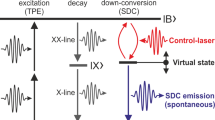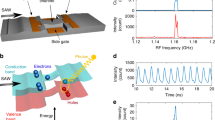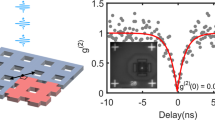Abstract
The coherent interaction of electromagnetic fields with solid-state two-level systems can yield deterministic quantum light sources for photonic quantum technologies. To date, the performance of semiconductor single-photon sources based on three-level systems is limited mainly due to a lack of high photon indistinguishability. Here we tailor the cavity-enhanced spontaneous emission from a ladder-type three-level system in a single epitaxial quantum dot through stimulated emission. After populating the biexciton (XX) of the quantum dot through two-photon resonant excitation, we use another laser pulse to selectively depopulate the XX state into an exciton (X) state with a predefined polarization. The stimulated XX–X emission modifies the X decay dynamics and improves the characteristics of a polarized single-photon source, such as a source brightness of 0.030(2), a single-photon purity of 0.998(1) and an indistinguishability of 0.926(4). Our method can be readily applied to existing quantum dot single-photon sources and expands the capabilities of three-level systems for advanced quantum photonic functionalities.
This is a preview of subscription content, access via your institution
Access options
Access Nature and 54 other Nature Portfolio journals
Get Nature+, our best-value online-access subscription
$29.99 / 30 days
cancel any time
Subscribe to this journal
Receive 12 print issues and online access
$259.00 per year
only $21.58 per issue
Buy this article
- Purchase on Springer Link
- Instant access to full article PDF
Prices may be subject to local taxes which are calculated during checkout





Similar content being viewed by others
Data availability
The data that support the findings of this study are available within the paper and the Supplementary Information. Source data are provided with this paper. Other relevant data are available from the corresponding authors on reasonable request.
References
W.F. Drake, G. Atomic, Molecular and Optical Physics (Springer, 2006).
M., Fox. Quantum Optics: An Introduction Vol. 15 (Oxford Univ. Press, 2006).
Senellart, P., Solomon, G. & White, A. High-performance semiconductor quantum-dot single-photon sources. Nat. Nanotechnol. 12, 1026–1039 (2017).
Uppu, R., Midolo, L., Zhou, X., Carolan, J. & Lodahl, P. Quantum-dot-based deterministic photon–emitter interfaces for scalable photonic quantum technology. Nat. Nanotechnol. 16, 1308–1317 (2021).
Schulte, C. H. H. et al. Quadrature squeezed photons from a two-level system. Nature 525, 222–225 (2015).
He, Y. et al. Dynamically controlled resonance fluorescence spectra from a doubly dressed single InGaAs quantum dot. Phys. Rev. Lett. 114, 097402 (2015).
Chou, C. W., Polyakov, S. V., Kuzmich, A. & Kimble, H. J. Single-photon generation from stored excitation in an atomic ensemble. Phys. Rev. Lett. 92, 213601 (2004).
Almendros, M. et al. Bandwidth-tunable single-photon source in an ion-trap quantum network. Phys. Rev. Lett. 103, 213601 (2009).
Pursley, B. C., Carter, S. G., Yakes, M. K., Bracker, A. S. & Gammon, D. Picosecond pulse shaping of single photons using quantum dots. Nat. Commun. 9, 115 (2018).
Pillet, P., Valentin, C., Yuan, R.-L. & Yu, J. Adiabatic population transfer in a multilevel system. Phys. Rev. A 48, 845–848 (1993).
Kuhn, A., Hennrich, M. & Rempe, G. Deterministic single-photon source for distributed quantum networking. Phys. Rev. Lett. 89, 067901 (2002).
Xu, X. et al. Coherent population trapping of an electron spin in a single negatively charged quantum dot. Nat. Phys. 4, 692–695 (2008).
Moreau, E. et al. Quantum cascade of photons in semiconductor quantum dots. Phys. Rev. Lett. 87, 183601 (2001).
Hu, Y. Z. et al. Biexcitons in semiconductor quantum dots. Phys. Rev. Lett. 64, 1805–1807 (1990).
Li, X. et al. An all-optical quantum gate in a semiconductor quantum dot. Science 301, 809–811 (2003).
Hwang, J. et al. A single-molecule optical transistor. Nature 460, 76–80 (2009).
Spinnler, C. et al. Optically driving the radiative Auger transition. Nat. Commun. 12, 6575 (2021).
Liu, F. Ultrafast depopulation of a quantum dot by LA-phonon-assisted stimulated emission. Phys. Rev. B 93, 161407 (2016).
Piatkowski, L. et al. Ultrafast stimulated emission microscopy of single nanocrystals. Science 366, 1240–1243 (2019).
Kianinia, M. et al. All-optical control and super-resolution imaging of quantum emitters in layered materials. Nat. Commun. 9, 874 (2018).
Kaldewey, T. et al. Far-field nanoscopy on a semiconductor quantum dot via a rapid-adiabatic-passage-based switch. Nat. Photon. 12, 68–72 (2018).
Liu, S. et al. Dual-resonance enhanced quantum light-matter interactions in deterministically coupled quantum-dot-micropillars. Light Sci. Appl. 10, 158 (2021).
Müller, M., Bounouar, S., Jöns, K. D., Glässl, M. & Michler, P. On-demand generation of indistinguishable polarization-entangled photon pairs. Nat. Photon. 8, 224–228 (2014).
Wang, H. et al. Towards optimal single-photon sources from polarized microcavities. Nat. Photon. 13, 770–775 (2019).
Huber, T. et al. Filter-free single-photon quantum dot resonance fluorescence in an integrated cavity-waveguide device. Optica 7, 380–385 (2020).
Schweickert, L. et al. On-demand generation of background-free single photons from a solid-state source. Appl. Phys. Lett. 112, 093106 (2018).
Schöll, E. et al. Crux of using the cascaded emission of a three-level quantum ladder system to generate indistinguishable photons. Phys. Rev. Lett. 125, 233605 (2020).
Brod, D. J. et al. Photonic implementation of boson sampling: a review. Adv. Photon. 1, 034001 (2019).
Giovannetti, V., Lloyd, S. & Maccone, L. Quantum metrology. Phys. Rev. Lett. 96, 010401 (2006).
Luo, Q. et al. Quantum random number generator based on single-photon emitter in gallium nitride. Opt. Lett. 45, 4224–4227 (2020).
Boto, A. N. et al. Quantum interferometric optical lithography: exploiting entanglement to beat the diffraction limit. Phys. Rev. Lett. 85, 2733–2736 (2000).
Kaer, P., Gregersen, N. & Mork, J. The role of phonon scattering in the indistinguishability of photons emitted from semiconductor cavity qed systems. N. J. Phys. 15, 035027 (2013).
Unsleber, S. et al. Two-photon interference from a quantum dot microcavity: persistent pure dephasing and suppression of time jitter. Phys. Rev. B 91, 075413 (2015).
Thomas, S. E. et al. Bright polarized single-photon source based on a linear dipole. Phys. Rev. Lett. 126, 233601 (2021).
Wang, H. et al. Near-transform-limited single photons from an efficient solid-state quantum emitter. Phys. Rev. Lett. 116, 213601 (2016).
Zhai, L. et al. Low-noise GaAs quantum dots for quantum photonics. Nat. Commun. 11, 4745 (2020).
Tomm, N. et al. A bright and fast source of coherent single photons. Nat. Nanotechnol. 16, 399–403 (2021).
Santori, C., Pelton, M., Solomon, G., Dale, Y. & Yamamoto, Y. Triggered single photons from a quantum dot. Phys. Rev. Lett. 86, 1502–1505 (2001).
Ding, X. et al. On-demand single photons with high extraction efficiency and near-unity indistinguishability from a resonantly driven quantum dot in a micropillar. Phys. Rev. Lett. 116, 020401 (2016).
Schimpf, C., Manna, S., Da Silva, S. F. C., Aigner, M. & Rastelli, A. Entanglement-based quantum key distribution with a blinking-free quantum dot operated at a temperature up to 20 K. Adv. Photon. 3, 065001 (2021).
Uppu, R. et al. Scalable integrated single-photon source. Sci. Adv. 6, eabc8268 (2020).
He, Y.-M. et al. Coherently driving a single quantum two-level system with dichromatic laser pulses. Nat. Phys. 15, 941–946 (2019).
Koong, Z. X. et al. Coherent dynamics in quantum emitters under dichromatic excitation. Phys. Rev. Lett. 126, 047403 (2021).
Reindl, M. et al. Phonon-assisted two-photon interference from remote quantum emitters. Nano Lett. 17, 4090–4095 (2017).
Claudon, J. et al. A highly efficient single-photon source based on a quantum dot in a photonic nanowire. Nat. Photon. 4, 174–177 (2010).
Gschrey, M. et al. Highly indistinguishable photons from deterministic quantum-dot microlenses utilizing three-dimensional in situ electron-beam lithography. Nat. Commun. 6, 7662 (2015).
Marty, G., Combrié, S., Raineri, F. & De Rossi, A. Photonic crystal optical parametric oscillator. Nat. Photon. 15, 53–58 (2021).
Naghiloo, M., Abbasi, M., Joglekar, Y. N. & Murch, K. W. Quantum state tomography across the exceptional point in a single dissipative qubit. Nat. Phys. 15, 1232–1236 (2019).
Nguyen, H. A. et al. Giant nonlinear interaction between two optical beams via a quantum dot embedded in a photonic wire. Phys. Rev. B 97, 201106 (2018).
Park, Y.-S., Roh, J., Diroll, B. T., Schaller, R. D. & Klimov, V. I. Colloidal quantum dot lasers. Nat. Rev. Mater. 6, 382–401 (2021).
Sbresny, F. et al. Stimulated generation of indistinguishable single photons from a quantum ladder system. Phys. Rev. Lett. 128, 093603 (2022).
Yan, J. et al. Double-pulse generation of indistinguishable single photons with optically controlled polarization. Nano Lett. 22, 1483–1490 (2022).
Acknowledgements
J.L. thanks K. Srinivasan for his continuing support and H. Shen for helpful discussions. This research was supported by National Key R&D Program of China (2018YFA0306101 and 2021YFA1400800), Key-Area Research and Development Program of Guangdong Province (2018B030329001), the Guangdong Special Support Program (2019JC05X397), the National Natural Science Foundation of China (62035017, 11874437, 12074442 and 91836303), the Local Innovative and Research Teams Project of the Guangdong Pearl River Talents Program (2017BT01X121) and the National Super-Computer Center in Guangzhou.
Author information
Authors and Affiliations
Contributions
J.L. conceived the project. S.-F.L. performed the numerical simulations. Y.Y., X. Su, S.L., X. Shang, H.L., H.H. and H.N. grew the QD wafers. S.-F.L. and X.L. fabricated the devices. J.I.-S. contributed to the theoretical modelling. Y.W., S.-F.L. and J.L. built the set-up and characterized the devices. J.L., S.-F.L. and Y.W. analysed the data. J.L. wrote the manuscript with inputs from all the authors. J.L., S.Y., Z.N. and X.W. supervised the project.
Corresponding author
Ethics declarations
Competing interests
The authors declare no competing interests.
Peer review
Peer review information
Nature Nanotechnology thanks Michael Reimer and the other, anonymous, reviewer(s) for their contribution to the peer review of this work.
Additional information
Publisher’s note Springer Nature remains neutral with regard to jurisdictional claims in published maps and institutional affiliations.
Extended data
Extended Data Fig. 1 Schematic of the setup for optical characterizations.
The setup consisting of 6 functional sections including cryogenic confocal system, pulse shaper, delay generator, spectrometer, filter set and HOM/HBT interferometers. BS: beam splitter, HWP: half-wave plate, LP filter: Long pass filter.
Extended Data Fig. 2 Indistinguishability and linewidth for different delay time.
The raw visibilities of the HOM interference for delay time of -46 ps (a), 18 ps (b) and 317 ps (c), respectively. The linewidths of the emission for delay time of -46 ps (d), 18 ps(e) and 317 ps (f), respectively.
Extended Data Fig. 3 Comparison of the metrics for the polarized single-source under different excitation schemes.
Excitation scheme, second-order correlation, Hong-Ou-Mandel interference and Blinking behavior for resonant excitation (a), TPE with stimulated lasers (b), LA-phonon assisted excitation (c) and two-color resonant excitation (d).
Supplementary information
Supplementary Information
Supplementary Figs. 1–7.
Source data
Source Data Fig. 2
Raw data for Fig. 2.
Source Data Fig. 3
Raw data for Fig. 3.
Source Data Fig. 4
Raw data for Fig. 4.
Source Data Fig. 5
Raw data for Fig. 5.
Source Data Extended Data Fig. 2
Raw data for Fig. E2.
Source Data Extended Data Fig. 3
Raw data for Fig. E
Rights and permissions
About this article
Cite this article
Wei, Y., Liu, S., Li, X. et al. Tailoring solid-state single-photon sources with stimulated emissions. Nat. Nanotechnol. 17, 470–476 (2022). https://doi.org/10.1038/s41565-022-01092-6
Received:
Accepted:
Published:
Issue Date:
DOI: https://doi.org/10.1038/s41565-022-01092-6
This article is cited by
-
Parity-time symmetry enabled ultra-efficient nonlinear optical signal processing
eLight (2024)
-
Dynamic resonance fluorescence in solid-state cavity quantum electrodynamics
Nature Photonics (2024)
-
Controlling the photon number coherence of solid-state quantum light sources for quantum cryptography
npj Quantum Information (2024)
-
Bright semiconductor single-photon sources pumped by heterogeneously integrated micropillar lasers with electrical injections
Light: Science & Applications (2023)
-
Telecom-band quantum dot technologies for long-distance quantum networks
Nature Nanotechnology (2023)



